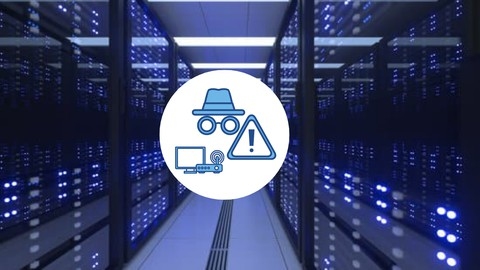Zero Trust security is a critical cybersecurity paradigm shift that’s rapidly becoming the standard for organizations worldwide.
It moves away from the traditional trust but verify approach to a never trust, always verify model, significantly enhancing security in the face of ever-evolving cyber threats.
By learning about Zero Trust, you can gain the knowledge and skills to design, implement, and manage secure systems that protect valuable data and infrastructure.
This knowledge is crucial for IT professionals, cybersecurity specialists, and anyone involved in protecting digital assets.
Finding the right Zero Trust course on Udemy, however, can be a challenge.
With numerous options available, each promising a comprehensive understanding of this complex topic, it’s easy to feel lost.
You need a course that not only covers the theoretical foundations but also provides practical, hands-on experience to truly master Zero Trust principles.
That’s why we recommend the Zero Trust Security Fundamentals for IT Professionals course as the best overall choice on Udemy.
This course provides a comprehensive overview of Zero Trust principles, architecture, and implementation strategies, making it ideal for IT professionals looking to build a solid foundation in this crucial security model.
It blends theory with real-world examples and practical exercises, ensuring you gain a deep understanding of how to apply Zero Trust in your organization.
While this is our top pick, we understand that you might have specific needs or preferences.
Therefore, we’ve compiled a list of other excellent Zero Trust courses on Udemy that cater to different learning styles and areas of focus.
Keep reading to explore these alternatives and find the perfect course to embark on your Zero Trust journey.
Zero Trust Security Fundamentals for IT Professionals
This Zero Trust Security Fundamentals course on Udemy guides you through establishing a secure IT environment.
You will begin by grasping the concept of Zero Trust, understanding its significance in today’s threat landscape.
The course explains how traditional perimeter security falls short in the face of modern cyberattacks.
You will delve into the core principles of Zero Trust, including the fundamental “never trust, always verify” approach.
The course explores Zero Trust Architecture (ZTA), a strategic framework for achieving Zero Trust security.
You will learn how to design and implement ZTA using the NIST model, a widely recognized standard.
Real-world examples and case studies, like the SolarWinds and Colonial Pipeline attacks, will demonstrate the practical implications of ZTA.
The course provides a detailed breakdown of Zero Trust’s five pillars: securing users, devices, networks, applications, and data.
You will also explore various Zero Trust maturity models from organizations like the NSA, CISA, and Microsoft, which help organizations assess their progress and plan their Zero Trust journey.
You will learn how to create a compelling business case for Zero Trust, build a dedicated team, and navigate the implementation process using proven strategies.
The course covers specific use cases, such as VPN-less implementations and conditional access, demonstrating how to apply Zero Trust principles to real-world scenarios.
Zero Trust Networking: The Future of Network Security
This Zero Trust Networking course starts with the history and importance of Zero Trust and then dives into the challenges of implementing it.
You learn about the NIST guidance for building a Zero Trust Architecture and its six key principles.
The course walks you through defining your network’s attack surface, implementing network traffic controls, and designing strong Zero Trust policies using tools and methods taught in the course.
You’ll gain a deep understanding of NIST’s framework and how to apply it to real-world situations.
You will explore practical applications of Zero Trust, including how it strengthens compliance, secures cloud migrations, and enables DevOps and Continuous Delivery.
You learn how to implement Azure Conditional Access policies, a crucial part of Zero Trust, and use MFA for enhanced security.
The course provides detailed steps for building a Zero Trust network, including planning, design, and ongoing monitoring.
You will learn about the different types of Zero Trust policies and practice implementing them in various scenarios.
You’ll gain practical skills and knowledge to create a secure and robust Zero Trust network.
This course helps you understand not only the “what” of Zero Trust but also the “how,” preparing you to implement these security measures effectively.
Zero Trust Security Masterclass - From beginner to mastery
You will begin by learning about the increasing need for Zero Trust in today’s digital world.
The course then takes you through the core principles of Zero Trust, highlighting both its advantages and disadvantages.
You will dive deep into the NIST standard, understanding its importance and how it provides a framework for implementing Zero Trust.
The course explores real-world situations, including specific case studies like [mention a specific case study from the syllabus] and [mention another specific case study].
The Zero Trust Security Masterclass doesn’t just stop at theory.
You will learn how to identify potential threats to Zero Trust security and develop a roadmap for successfully implementing it in your own company.
The course highlights the common challenges organizations face during Zero Trust implementation, such as lack of support, and offers solutions to overcome them.
You will study various Zero Trust maturity models, which will help you assess your organization’s progress.
The course uses knowledge checks after each section to ensure you grasp all the concepts.
Master Course in Zero Trust Architecture 2.0
This course begins by introducing you to Zero Trust Architecture 2.0 and why it’s so important in today’s world.
You quickly dive into its goals, the main ideas behind it, how to keep it running smoothly, and the important parts that make it up.
You discover how big names like Microsoft, Oracle, and IBM use Zero Trust in their own systems.
You then move on to the guidelines and structure that shape a Zero Trust Architecture.
The course doesn’t stop at theory - it shows you how to build your own Zero Trust system and create a strategy around it.
You learn about important concepts like always checking who’s accessing what, giving the least amount of access necessary, and dividing your network into smaller, more secure sections.
Apply Zero Trust Security Model for Azure Virtual Desktop
This comprehensive course on Azure Virtual Desktop security takes you on a journey from foundational principles to advanced implementation techniques.
You’ll begin by mastering the Zero Trust Security Model, a modern approach that dictates never trusting anything or anyone, even within your network.
This principle, when applied to Azure Virtual Desktop, ensures a robust security posture for your cloud-based desktop environment.
Next, you’ll dive into the critical domain of Identity and Access Management.
Learn how to leverage Role-Based Access Control (RBAC) to granularly control who can access specific resources within AVD.
You’ll implement Multi-Factor Authentication (MFA) and Azure AD Conditional Access policies, significantly bolstering security.
The course also explores enabling single sign-on (SSO) and passwordless authentication for a frictionless user experience while maintaining high security standards.
Data and Threat Protection become the focus of the subsequent module.
You’ll discover best practices for safeguarding sensitive data, including utilizing Azure Disk Encryption to protect your session host disks.
Tools like Microsoft Purview enable you to classify your AVD data, ensuring appropriate access control and security measures.
You’ll learn to implement screen capture protection and watermarking, further deterring unauthorized data access.
Additionally, the course delves into Microsoft Defender Application Control, a powerful tool for preventing unauthorized software from running on your AVD session hosts.
Moving on to Security and Compliance, you’ll gain mastery over Azure Firewall and its policies, enabling you to control access to AVD host sessions.
You’ll learn to configure Just-in-Time Access, granting access to session hosts only when needed.
This module also introduces you to Azure Bastion, a secure gateway for connecting to your Azure Virtual Machines.
Finally, the course concludes with Azure Virtual Desktop Governance and Compliance, covering essential aspects of policy enforcement and compliance assurance.
Learn how to prevent unwanted software from running on session hosts, leverage Trusted Launch for enhanced security, and effectively schedule agent updates.
The course emphasizes the importance of Azure Policies for enforcing rules and utilizing Microsoft Defender for Cloud to monitor and protect your AVD environment.
Practical Zero Trust Implementation
You will begin by building a strong understanding of zero trust principles and their alignment with industry standards like the NIST architecture.
You will learn how to evaluate and select appropriate zero trust solutions based on your specific needs and explore various use cases for zero trust security.
The course guides you through the process of conducting a zero trust readiness assessment to determine your organization’s preparedness.
You will learn how to develop a comprehensive zero trust strategy, create a clear roadmap for implementation, and align it with a realistic case scenario.
The course emphasizes hands-on learning through practical labs using Microsoft Azure Zero Trust services.
You will gain practical experience in implementing zero trust solutions within the Azure environment.
You will work through step-by-step labs, addressing common challenges and utilizing powerful tools for successful implementation.
The course goes beyond technical implementation by introducing you to a business-oriented approach to zero trust adoption.
You will explore the Zero Trust Adoption Framework and learn how to apply its lifecycle to different business cases, considering specific business needs and requirements.
Xage Zero Trust Blockchain-Protected Fabric for IIOT
This course dives deep into zero trust security for industrial IoT systems.
You’ll begin with the foundations of zero trust and the architecture behind Xage’s platform.
Then, the course guides you step-by-step through setting up and configuring Xage’s system.
You’ll learn how to secure your IIOT systems using remote access, file transfer, and data exchange.
This course gets practical, focusing on installation and configuration.
You’ll learn to navigate the user interface like a pro.
You’ll also discover how to manage users and groups and how to enforce MFA for ironclad security.
You’ll even master the art of setting up secure WebSSH access policies.
And that’s not all – you’ll gain valuable insights into session collaboration and how to manage it effectively.
This course goes beyond theory, providing practical examples and demonstrations to solidify your understanding.
You’ll learn by doing, gaining hands-on experience with Xage’s powerful platform.
Imagine having the ability to implement secure remote access, ensuring that only authorized users can access critical systems.
Picture yourself confidently configuring file transfer protocols, safeguarding sensitive data during transmission.
By the time you finish this course, you’ll have the knowledge and skills to confidently implement and manage Xage Zero Trust for your IIOT environment.
You’ll transform into a zero-trust expert, ready to protect your organization’s most valuable assets.
Learn FortiGate Zero Trust Network Access-Hands On Labs
If you’re searching for a top-notch Zero Trust course, this one on FortiGate Zero Trust Network Access could be a perfect fit.
The course begins by laying a strong foundation, taking you through the core concepts of ZTNA and how it all works.
You’ll explore the different parts of a ZTNA system and understand how they work together to create a secure network.
The course then dives into the practical side, showing you how to configure FortiClient EMS, a tool that manages all your FortiClient endpoints.
You will learn to connect FortiClient to FortiClient EMS and make it work seamlessly with your existing Active Directory setup.
The course helps you set up and manage user profiles and create rules that control access to your network based on whether a user is on or off the company network.
This course goes beyond the basics and equips you to handle real-world situations.
You’ll discover how to use ZTNA to secure various types of connections, including web traffic (HTTP/HTTPS), secure shell access (SSH), and remote desktop connections (RDP).
The course doesn’t shy away from authentication, a critical aspect of security.
You’ll learn how to implement robust authentication methods such as LDAP and SAML with your ZTNA setup.
This ensures that only authorized users gain access to your network.
You’ll also discover how to use ZTNA with VPNs.
This is especially helpful if you’re transitioning from a traditional VPN setup to a more modern and secure ZTNA environment.








